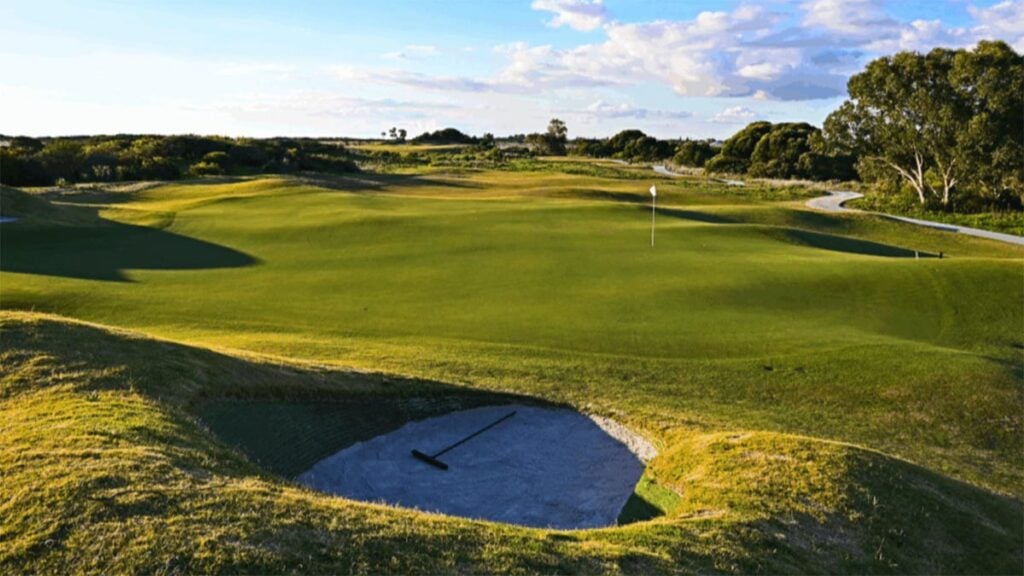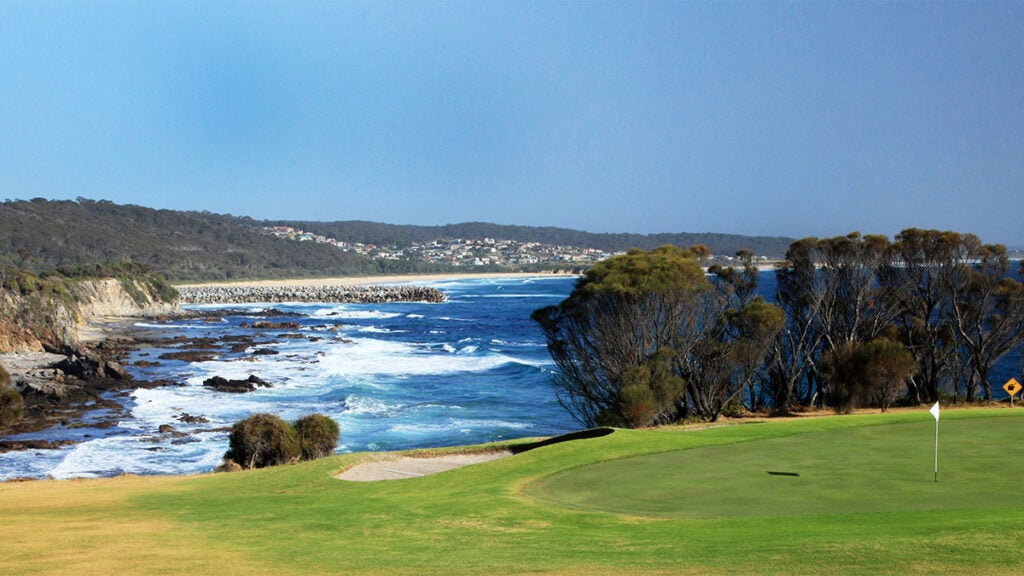In the short but robust tradition of covering road-related content ahead of a major championship (see our Q&A on the turnpike running through Oakmont), we’re pleased now to bring you some content on another topic that has very little to do with golf, but that is somehow affecting play this week at Royal Portrush:
A parade.
RELATED: R&A chief confirms talks with Donald Trump’s son over challenges for return to Turnberry
But not just any parade! This parade is a politically divisive, historically combustible and arguably provocative march that will have a lot of people feeling a lot of very strong emotions along the Catholic-Protestant split in Northern Ireland. And it’s relevant to golf because the R&A, governing body of the Open Championship, is so worried about it that they reportedly offered £20,000 to the Portrush Sons of Ulster to postpone. That group, associated with – if not directly affiliated with – the Orange Order, declined, so now the R&A is adjusting tee-times to get spectators out slightly earlier to avoid the “congestion” that might come with thousands of people spilling out of the course at the exact same time that the parade begins. (By the way, remember the colour orange.)
So, what’s actually going on here? Why is this parade such a big deal? Let’s tackle this, Q&A style.
Do we have to go back in time to understand this thing? Are you going to force us to learn history?
I’m afraid so.
Like, 30 or 40 years back?
How about the year 1534.
Oh no.
I don’t like it either, but without context none of this makes sense. We’ll do some quick bullet points, how’s that?
Fine.
* So, 1534. Henry VIII, a famously weird guy, wanted a male heir, but his wife Catherine had the audacity to have a daughter instead. Henry sought a divorce so he could marry a different woman (who he would later behead), but the pope wouldn’t give it to him, so he started his own church, made himself the head of it, and eventually most of Great Britain became Protestant.
* The English tried to sell the Protestant stuff to Ireland, who said, ‘No thanks, we’re happy being Catholics, and also, we don’t like you.’ Thus, a religious split formed, and one that would spell serious problems in the future.
* Fast-forward to the 1600s and 1700s, and the Plantation of Ulster, where farmers from England and Scotland were given lots of land in north-eastern Ireland, moved over, and immediately started fighting with Catholics, who didn’t enjoy all this colonising business.
* Rebellions ensued, which all came to a head when William III, King of England, defeated James II and his Irish followers at the Battle of the Boyne, solidifying Protestant rule in Ireland for centuries to come.
This William III fellow… did he have a nickname that will provide a dramatic narrative revelation for our Q&A?
Yes, he did. William III was known as… William of Orange.

Photo: MWF
Wow. So the “Orange Order”, and the orange clothing worn by some of these marchers in Portrush and across Northern Ireland, and indeed the orange stripe in the flag of the Republic of Ireland, it’s all commemorating the victory of William over his Catholic enemies in 1690?
You got it.
Why orange?
It’s a French/Dutch thing, don’t worry about it.
OK, but how do we get from there to a march at a golf tournament?
Buckle up for more bullet points:
* After William won, decades and centuries of sectarian violence ensued, failed rebellions, things of that nature. At a certain point, though, a more hopeful “home rule” movement grew, and after a lot more fighting, in 1921 the Irish successfully negotiated to become a “free state”, which was a prelude to becoming a sovereign country in 1948.
* However, because all those Protestant settlers and their descendants were still up north, six counties were excluded, and remained part of the UK. This was Northern Ireland, and even back then, people on all sides recognised that the partition was a disaster in the making.
* By the ’60s, Catholics in Northern Ireland began antagonising for housing and economic rights, the remnants of the Irish Republican Army continued fighting for a united Ireland, and the Protestant leadership in the north responded harshly, all of which led to the British Army being called in. The Catholics were actually happy about that at first, a state of affairs which, uhhhh… did not last, and the country was soon mired in a period referred to now as “the Troubles”, marked by warring paramilitary groups, sectarian violence, bombing and general civic unrest across the six counties. We’re skipping so much here, like Bloody Sunday, Bobby Sands and the hunger strikes and various broken ceasefires, but in 1998 the Good Friday agreement was signed, which ushered in an era of relative peace that continues today.

Photo: Oisin Keniry/R&A
Wow. Did the Troubles hit home for any golf personalities?
It hit home for almost everyone, but a particularly horrific example came in 1972, when Rory McIlroy’s great-uncle, Joseph McIlroy, was gunned down in his home and died in front of his wife and four daughters for the apparent crime of being a Catholic who moved into a Protestant neighbourhood. And more broadly, the Troubles are the reason why the Open Championship stayed far away from Northern Ireland between the first Open at Portrush in 1951 and the next one in 2019. (If you’d like to listen to a lot more content on Rory and the complicated relationship with his country, produced by a very smart and talented man, you can do so here.)
OK, what about the marches?
Yes, now we come to the so-called “orange walks”. The marching season lasts roughly from April to August every year across Northern Ireland, and they’re organised by loyalists from the Orange Order and similar groups. Some Catholics see them as sectarian and very unfriendly – “triumphalist”, to quote Wikipedia, essentially rubbing their faces in past victories and making current tensions worse – and they’ve led to fighting and riots and other ugliness, especially when they march through Catholic neighbourhoods. (Perhaps you’ve seen the “Derry Girls” episode on the topic.) The marches have been happening in various forms since 1796, and today there are thousands of them across Northern Ireland, including the annual parade of the Portrush Sons of Ulster this Saturday, which has been going on for at least 40 years. The vast majority of the parades, today, do not result in violence.
Did they have to do it in Open Championship week?
A little sleuthing on their Facebook page indicates that at least for the past five years, they’ve held the march shortly after the July 12 national marches which specifically celebrate the Battle of the Boyne, so on that front they’re consistent. Does the spectre of a bigger audience with such a huge event in town appeal to them? It’s unclear. They did refuse that £20,000 offer from the R&A, but groups like these have a long history of refusing to negotiate on the marches, so you can’t read much into that.
Beyond the failed monetary offer, what has the R&A done?
Mark Darbon, the new chief executive of the R&A, spoke briefly on the topic overnight (Australian time).
“Recognising the events that are taking place on Saturday,” he said, “we’ve worked really collaboratively with the organisers and across multiple agency groups to ensure primarily that both events can run as seamlessly as possible. We’re making a slight tweak to tee-times to try and finish – it’s not dramatic. It’ll be 15 minutes or so earlier.”
A moment later, asked about the rejected £20,000 offer, he said, “we’re actually contributing some incremental costs to support what I just said, the seamless operation of both events.”
Unfortunately, there wasn’t enough time in the press conference to ask the obvious follow-up – how much money is the R&A giving the Sons of Ulster, and for what? A reasonable guess would be security precautions, but that isn’t confirmed.

Photo: Richard Heathcote
What will the parade be like?
Apparently there will be more than 60 bands with more than 2,000 participants on hand, the march starts at 8:30pm, and parts of it may have been re-routed at the R&A’s request. They can’t move it any later, they said, due to the 11pm curfew. The path of the march is basically just around the town, starting to the west of Royal Portrush. This appears to be footage of the parade from 2023. The basic worry here is what will happen when tens of thousands of fans pour out of the golf course gates and walk immediately into a big parade. What happens then? I guess we’ll see!
Don’t I remember hearing about this in 2019?
Yes, it was very similar. Back then Ewan Murray of The Guardian called it an “embarrassing problem”, and said that, “shows such as this represent a depressing throwback to a Northern Ireland beset by sectarian division.” In response, one letter argued that it’s just an entertaining fundraising event, unaffiliated with the Orange Order, that anyone could enjoy, including fans from the Republic of Ireland. In the end, the parade was severely curtailed, and the result was essentially an outdoor concert.
In other words, it will be much bigger this year.
Much bigger.
Anything else I should know?
Maybe just that the history of Northern Ireland is endlessly fascinating, and if any of this has intrigued you, books like Say Nothing might be right up your alley.
And in conclusion, all of this has been to explain a 15-minute tee-time adjustment in the third round of the Open Championship?
That’s right. You’re welcome. Enjoy the golf.




